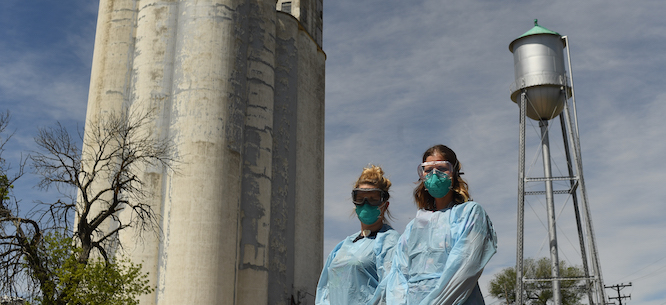The Disease Map of Rural America
The Disease Map of Rural America
In the hardest-hit rural communities, the collective immune system was already fatally compromised. They were deep into a decades-old crisis when the pandemic arrived.

This essay is part of a special section on the pandemic in the Summer 2020 issue.
There have been two sides to the coronavirus pandemic in rural America. In many rural places, like the Vermont town of 2,500 people where I live, the sense of crisis is palpable in every empty grocery story, in every conversation held with a neighbor from across an otherwise empty country road. Yet the disease itself remains relatively scarce. With eight confirmed COVID-19 cases in the entire county by the middle of May, I would likely have to cover several hundred square miles to encounter as many cases as have been contracted on the single block in Upper Manhattan where I grew up. Nationwide, the virus’s fatality rate in rural areas is roughly one-tenth of what it is in urban areas. Unsurprisingly, many of the earliest and loudest protests against state-mandated public health restrictions and business closures have emanated from these kinds of non-urban locales, where case and death rates have so far been minimal: Upstate New York, central Michigan, throughout the Upper South and the Plains.
In other parts of rural America, the story is quite different. Rural communities with populations that are whiter, where the gap between rich and poor is relatively narrow, and where there is not much industrial activity—like my Vermont town—have fared much better than rural communities that do not fit those descriptions. In Lexington, Mississippi, in the heart of the Southern Black Belt, the rate of transmission has been three times higher than in Los Angeles. In Cameron, Arizona, a speck of a town in the western reaches of the Navajo Nation, the rate is roughly equivalent to Chicago’s. In Eagle County, Colorado, home to the gilded slopes of Vail Ski Resort and some of the worst income inequality in the state, it’s higher than in Detroit. In Worthington, Minnesota, the site of the third-largest pork processing plant in the country, as well as one of the fastest growing Latino populations in the region, the number of confirmed cases per capita is not far behind New York City’s. And at the time of writing, seven of the ten largest coronavirus hot spots in the United States could be found in prisons located in predominantly rural areas.
The existence of these harder-hit pockets should come as no surprise. Residents of rural communities are generally older and poorer than the average American. They are less likely to have adequate health insurance, and more likely to suffer from pre-existing conditions that can exacerbate the effects of the virus, like diabetes. Rural places are also woefully underserved by a barebones infrastructure of medical providers and hospitals. All of that makes rural America broadly vulnerable to a public health crisis of this sort. And yet the general picture does not explain why outcomes have been so variable during the first wave of the pandemic.
In rural America, like elsewhere, speaking of the virus as a great leveler distorts reality. It is more apt to call it a great amplifier. That is the only way to make sense of why the experience of the pandemic thus far has been so much worse in hubs of certain kinds of dangerous and lightly regulated industry than in places that are not oriented around such types of work; so much worse in resort communities and prison towns than in rural areas that are sustained by more balanced and equitable forms of economic activity; so much worse, above all, in rural places where people of color live with the ongoing legacies of violent displacement, enforced segregation, political disenfranchisement, and social marginalization. These are places where rural America’s collective immune system was already fatally compromised; where rural America was already deep into a decades-old crisis when the latest one hit.
If the first symptoms of rural discontent in the pandemic era have been right-wing, anti-state convulsions, let us hope they will not be the only kinds of protest we see. Perhaps the coronavirus pandemic will amplify these multiple and overlapping structural crises confronting rural America in another way as well; perhaps it will make them louder, harder to ignore. For those of us who want to build a majoritarian working-class coalition capable of securing national political power, making real headway in rural America is a must (as demonstrated most recently when Bernie Sanders’s campaign ran aground once again in the Black Belt and the rural Midwest). For those who balk at that notion for fear that it will entail conciliatory overtures to petit-bourgeois ethno-nationalists, the geography of the coronavirus pandemic should serve as a reminder: campaigns for economic, racial, and social justice can find eager adherents in vast swathes of rural America.
Maybe, then, the disease map of rural America will end up serving as a different kind of map as well—one that can point the way to a new landscape of possibility for left-wing politics and coalition-building in the post-pandemic world to come.
Max Fraser is a historian and a writer. He co-edited, with Garrett Dash Nelson, the special section on “Left Paths in Rural America” that appeared in Dissent’s Fall 2019 issue.






